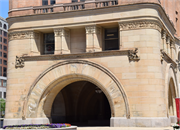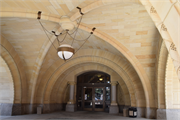Property Record
200 E WELLS ST
Architecture and History Inventory
| Historic Name: | Milwaukee City Hall |
|---|---|
| Other Name: | MILWAUKEE CITY HALL |
| Contributing: | |
| Reference Number: | 16297 |
| Location (Address): | 200 E WELLS ST |
|---|---|
| County: | Milwaukee |
| City: | Milwaukee |
| Township/Village: | |
| Unincorporated Community: | |
| Town: | |
| Range: | |
| Direction: | |
| Section: | |
| Quarter Section: | |
| Quarter/Quarter Section: |
| Year Built: | 1895 |
|---|---|
| Additions: | 1898 |
| Survey Date: | 19842010 |
| Historic Use: | city hall |
| Architectural Style: | German Renaissance Revival |
| Structural System: | |
| Wall Material: | Brick |
| Architect: | Henry C. Koch and Esser |
| Other Buildings On Site: | |
| Demolished?: | No |
| Demolished Date: |
| National/State Register Listing Name: | Milwaukee City Hall |
|---|---|
| National Register Listing Date: | 3/14/1973 |
| State Register Listing Date: | 1/1/1989 |
| National Register Multiple Property Name: |
| Additional Information: | A 'site file' exists for this property. It contains additional information such as correspondence, newspaper clippings, or historical information. It is a public record and may be viewed in person at the Wisconsin Historical Society, Division of Historic Preservation. HABS WI-254. As Milwaukee became America’s most Germanic city in the 1880s, it outgrew the old city hall, crammed into the Italianate cream-brick Market Hall since the 1860s. Berlin-born Mayor Emil Wallber declared the need for a new city hall in 1886. Political wrangling delayed action until 1891, when the Common Council announced a competition to design a new facility. Hamburg-born Mayor John C. Koch took office in 1893 and the city approved a new building. The mayor’s fellow Deutscher Club member, Henry C. Koch won the design competition with his Americanized version of a German Renaissance rathaus (town hall), with four “beer-stein” turrets flanking its central bell tower. By its completion in 1895, more than half of Milwaukee’s population was either German-born or second generation, and City Hall’s Germanic stylings mirrored the city’s reputation as the “Deutsch Athens.” Constructed in 1893-1895 by Henry C. Koch & Co., this large Victorian Eclectic building is made of sandstone, St. Louis red pressed brick, and terra cotta, with a massive front entrance tower. It was the tallest building in Milwaukee for 78 years. This building is also a contributing resource of the Plankinton-Wells-Water Street Historic District (listed: 6/13/1986). Locally designated: 11/9/1982. Listed as a NHL on 4/5/2005. $75 million renovation completed in 2009. Resurveyed for Milwaukee Downtown Connector Arch/History Survey, SHPO#10-0983, Prepared by Heritage Research (2010). "This monumental example of civic architecture is probably Milwaukee's best known symbol of its German-American heritage. The building stands on an unusual triangular site that was the location of Milwaukee's first market hall and city hall. The need for a structure big enough to accommodate all city departments under one roof was already evident by the early 1880s, but political wrangling delayed action until 1891 when an architectural competition was officially announced by the Common Council to get designs for a new city hall. From the eleven submissions, the plans of local architect H. C. Koch & Co. were chosen. The Tuetonic style winning design was considered to be the most suitable for a city known as the time as the Duetsche-Athens. Patterned after a German "rathaus" or town hall, Koch ornamented the dormers and tower with German Renaissance style shaped gables. He also incorporated much sculptural detail, including putti or cherubs, winged griffins, and the heads of foxes or wolves to satisfy the German taste for rich carved ornament. Romanesque influence is visible in the extensive use of arches at the upper story and at the base of the 350-foot tower where carriages could once drive directly up to the front entrance. The 8-story-tall skylit atrium space inside was an innovative and strikingly modern feature for its time. It is embellished with ornamental railings of bronze finished cast iron, a patterned mosaic-tile floor, and stencils recreated from the originals by Conrad Schmitt Studios in 1992. City Hall, was is open to the public on weekdays, is considered by many experts to be the finest German style public building in America. It is a Milwaukee Locally Designated Historic Building and is located within the Plankinton/Wells/Water Street National Register Historic District. Architect Henry C. Koch borrowed features from actual German city hall buildings for the design of Milwaukee's City Hall including the arches at the first story entrance, the tower, and the shaped gables." MILWAUKEE ETHNIC COMMERCIAL AND PUBLIC BUILDINGS TOUR, CITY OF MILWAUKEE DEPARTMENT OF CITY DEVELOPMENT, 9/1994. |
|---|---|
| Bibliographic References: | MILWAUKEE ETHNIC COMMERCIAL AND PUBLIC BUILDINGS TOUR, CITY OF MILWAUKEE DEPARTMENT OF CITY DEVELOPMENT, 9/1994. MILWAUKEE HISTORIC BUILDINGS TOUR: JUNEAUTOWN, CITY OF MILWAUKEE DEPARTMENT OF CITY DEVELOPMENT, 1994. MILWAUKEE JOURNAL 1/23/1995. Inland Architect and News Record, #5, 12/1892. "City Hall Project Completed Under Budget," MILWAUKEE JOURNAL-SENTINEL, 4 Oct 2009. Buildings of Wisconsin Manuscript. Pagel, Mary Ellen & Virginia Palmer for the University of Wisconsin Extension Division, Guides to Historic Milwaukee: Juneautown Walking Tour, 1965. |
| Wisconsin Architecture and History Inventory, State Historic Preservation Office, Wisconsin Historical Society, Madison, Wisconsin |





